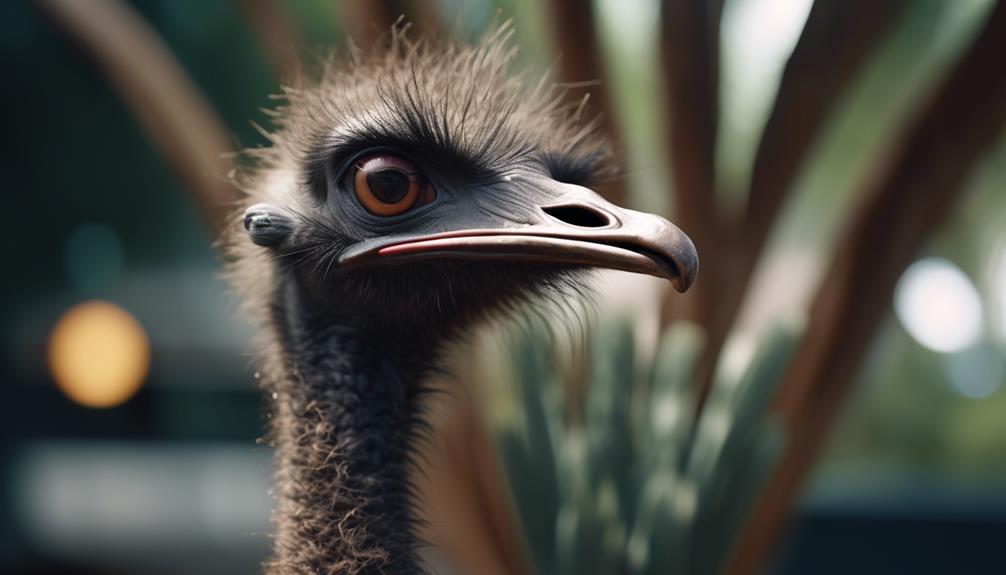
As you observe the graceful stride of an emu, its long neck reaching out to graze on the lush grass, have you ever wondered what lies beneath the surface? Emu anatomy holds a fascinating world of unique features and adaptations that allow this flightless bird to thrive in its environment.
From the intricate skeletal structure to the efficient respiratory and digestive systems, there is much to uncover.
But it doesn't stop there. The emu's reproductive system also holds its own secrets.
So, prepare to embark on an intriguing journey as we explore the remarkable anatomy of these captivating creatures.
Key Takeaways
- Emus have elongated and sturdy bones, adapted for their impressive height and high-speed running.
- Their skeletal system includes fused ribs for stability and protection, as well as denser and more solid bones compared to other birds.
- Emus have powerful leg and wing muscles, contributing to their ability to run at high speeds and maintain balance.
- The respiratory system of emus is well-adapted for efficient oxygen extraction, with two air sacs, a powerful diaphragm, and well-developed intercostal muscles.
Skeletal Structure
The skeletal structure of emus is distinct and plays a crucial role in their unique physical abilities and adaptations. Emus possess a specialized skeletal system that has evolved over time to support their large, flightless bodies and enable efficient movement.
One key aspect of emu skeletal development is their elongated and sturdy bones, which contribute to their impressive height of up to 6 feet. These long bones are composed primarily of calcium phosphate, a mineral that provides strength and rigidity. The arrangement of these bones, particularly in the legs and pelvic region, gives emus the ability to run at high speeds and navigate challenging terrains.
Comparatively, emus have a different skeletal structure than other birds. While most birds have hollow bones to reduce weight for flight, emus have denser and more solid bones, which support their ground-dwelling lifestyle. Additionally, emus have a unique arrangement of their ribcage, with fused ribs that provide stability and protection to their internal organs.
This adaptation allows emus to withstand the impact of their powerful kicks and provides additional support for their large bodies.
Muscular System
Emus exhibit a highly developed muscular system that enables them to carry out their unique physical activities with efficiency and precision. Their muscular adaptations are crucial for their distinctive locomotion patterns. Here are some key features of the emu's muscular system:
- Powerful leg muscles: Emus possess strong leg muscles that allow them to run at high speeds. These muscles, particularly the quadriceps and hamstrings, provide the necessary force for their swift and agile movements.
- Well-developed wing muscles: Although emus are flightless birds, their wings haven't completely lost their function. The wing muscles in emus are still present and contribute to their balance and stability while running. These muscles are also used for displays during courtship rituals.
- Strong neck and chest muscles: Emus have robust neck and chest muscles that assist in their unique head movements. These muscles allow them to tilt their heads and extend their necks to reach vegetation or prey on the ground.
- Adapted abdominal muscles: Emus have specialized abdominal muscles that aid in their breathing patterns. These muscles contract and relax to facilitate efficient respiration, particularly during prolonged running or to cool down in hot climates.
The emu's muscular system is a remarkable example of adaptation and efficiency, enabling them to thrive in their natural habitats.
Respiratory System

With their muscular adaptations facilitating efficient respiration, emus demonstrate an intricate respiratory system that complements their unique physical abilities. Emus possess a highly developed respiratory system that allows them to thrive in their natural environment. Their respiratory adaptations enable them to efficiently extract oxygen from the air and remove waste gases, ensuring a constant supply of oxygen to their bodies.
Emus have a unique breathing mechanism that sets them apart from other birds. Unlike most species, emus have two air sacs located in their thoracic cavity. These air sacs act as reservoirs, storing and circulating air throughout their respiratory system. This allows for a continuous flow of oxygen, ensuring a constant supply to their muscles during their high-energy activities.
Additionally, emus have a large and powerful diaphragm, which aids in the expansion and contraction of their lungs. This diaphragm, along with their well-developed intercostal muscles, allows for efficient inhalation and exhalation. Emus can take in large volumes of air with each breath, supporting their high energy demands and enabling them to sustain their impressive speed and endurance.
Digestive System
Featuring a digestive system uniquely adapted to their herbivorous diet, emus possess specialized anatomical structures that facilitate efficient digestion and nutrient absorption.
Their digestion process begins in the beak, where emus use their sharp, serrated beaks to tear off plant material. Once ingested, the food travels down their long esophagus into a muscular organ called the crop, where it's stored temporarily.
From the crop, the food enters the glandular stomach, also known as the proventriculus, where it's mixed with digestive enzymes and acids. Next, the food moves into the muscular stomach, or gizzard, which contains small stones that aid in grinding and breaking down the tough plant fibers. The gizzard contracts and relaxes, effectively churning the food.
Finally, the partially digested food enters the small intestine, where the majority of nutrient absorption takes place. Emus have a relatively long small intestine, allowing for thorough digestion and absorption of nutrients from their plant-based diet.
This unique digestive system enables emus to efficiently extract essential nutrients from their food, meeting their specific diet and nutritional needs.
Reproductive System

The reproductive system of emus exhibits distinct anatomical features that enable successful reproduction and breeding. Emus, like many other avian species, have internal fertilization. However, their reproductive anatomy differs in several ways compared to other birds.
One notable feature of the emu reproductive system is the presence of a cloaca, a common opening for excretion and reproduction. In male emus, the cloaca houses the reproductive organs, including the testes and sperm ducts. In females, the cloaca serves as the site for egg laying and also for receiving sperm during copulation.
Emus have a unique breeding behavior where the males take the primary responsibility for incubating the eggs. During the breeding season, males develop a brood patch on their belly, which consists of a featherless area with a rich blood supply. This brood patch is used to transfer heat to the eggs during incubation.
Emus have a complex reproductive cycle, with breeding typically occurring during the cooler months. The female emu lays a clutch of eggs, usually consisting of 5 to 15 eggs, in a nest prepared by the male. The male then incubates the eggs for approximately 56 days until they hatch.
Overall, the reproductive system of emus showcases unique adaptations that enable successful breeding and reproduction. Their distinct breeding behavior and reproductive cycles contribute to the survival of this fascinating species.
| Aspect | Male Emus | Female Emus |
|---|---|---|
| Reproductive Role | Incubation of Eggs | Egg Laying |
| Cloacal Structure | Houses Testes | Receives Sperm |
| Breeding Season | Cooler Months | Cooler Months |
Frequently Asked Questions
How Fast Can Emus Run?
Emus can run surprisingly fast, reaching speeds of up to 30 miles per hour. Their long legs and powerful muscles enable them to cover vast distances quickly, making them one of the fastest land birds.
What Is the Average Lifespan of an Emu?
On average, emus have a lifespan of around 10 to 20 years. This may seem short compared to other birds, but it is influenced by their unique breeding habits and population trends.
Do Emus Have Any Natural Predators?
Emus in captivity have minimal predators due to their size and aggression. However, in the wild, emus face threats from dingoes, feral dogs, and wedge-tailed eagles. Emu conservation efforts aim to protect them from these natural predators.
Are Emus Social Animals or Do They Prefer to Be Solitary?
Emus are social animals, often found in groups called mobs. They communicate through various vocalizations and body language, such as drumming sounds and displays of dominance. However, there are instances where emus prefer to be solitary, especially during nesting and raising their young.
How Do Emus Defend Themselves Against Threats or Predators?
Emus defend themselves against threats and predators through various defense mechanisms. They have strong legs that enable them to kick with force, inflicting damage. Additionally, their ability to blend into their surroundings through camouflage strategies helps them avoid detection.
Conclusion
As you delve into the intricate anatomy of emus, their unique features become increasingly fascinating.
From their sturdy skeletal structure, allowing them to effortlessly navigate their environment, to their powerful muscular system, enabling impressive speed and agility.
Their efficient respiratory system ensures a steady oxygen supply, while their digestive system efficiently processes their herbivorous diet.
Lastly, the reproductive system ensures the continuation of their species.
Emus truly embody the marvels of nature, a testament to the intricate beauty of evolution.




